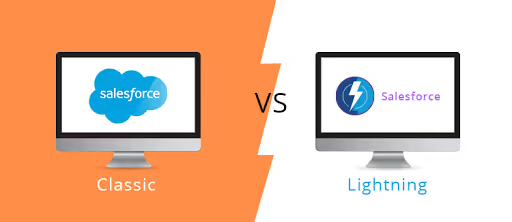
Salesforce Classic and Salesforce Lightning are two versions of the Salesforce CRM. If you are not aware, Salesforce provides CRM (customer relationship) entities with tools to record multidiscipline information and facilities for following, observing, and analyzing data. In the CRM field, Salesforce are a highly preferred asset.
It is due to the ease of use and customizability. However, there are other popular solutions in the market (SAP, Oracle, Microsoft, etc.) To maintain its top position, Salesforce comes up with unique and innovative solutions. These help organizations understand their true maximum potential.
What is Salesforce Classic?
Classic is the original Salesforce interface. It is quite popular among Salesforce veterans in the industry. The Classic version has some necessary features for CRM, like the collection and storage of sales data, customizable dashboards, tasks, and events display on the homepage, integrated email templates, etc.
The Interface
At first glance, one can easily say that the Classic version does not have modern UI. It is compact, and little attention is paid to icons and graphics. The UI is mostly text-centric. There are a few graphics. They are, however, not displayed in high resolution. The default font size is not quite pleasing to the eye. In certain layouts, there is a lot of unused space.
It looks like a lot of content is squeezed into a small space. This version’s dashboard focuses more on the text. The Home tab looks more like a news feed that displays the latest tasks and emails. Due to the UI in this version, navigation can be challenging.
Fading Popularity
People who are new to Salesforce may not even be aware of the Classic version. It is believed that this version is going to become obsolete (not very soon, however). Although Salesforce hasn’t officially announced an end date for support for Classic, its future is a little uncertain.
Salesforce Lightning vs Classic– A Quick Comparison
The main reason for the fading popularity of the Classic version is Salesforce Lightning. Introduced in 2016, Lightning is a CRM tool with a modern UI. It supports most of the features of Classic, and much more.
Old organizations are switching to Lightning, while the new ones are by default directed to the Lightning version when they sign up. What are the features of Lighting, that makes it more popular than Classic? Let us see.
- A Better UX for End-Users
End-users are given autonomy to make minor customizations. With Lightning, Salesforce services have introduced drag and drop functionality for admins. Admins do not have to wait and collaborate with a developer for small changes like rearranging components on their page or make minor modifications.
This eliminates the need to often turn to Visual Force. Coding is not a single step process. There are other steps involved, such as testing, deployment, and maintenance. If there are uncaught errors, the developer needs to go back to square one. Having to follow this repeatedly for minor changes can prove to be costly.
This doesn’t mean that Salesforce Development Services are no longer required. Visual Force developers can now concentrate on customization projects and app development, as small changes can be handled by the end-users.
- Einstein (Wave) Analytics
The Lightning version has superior reporting features that are absent in Classic. In Classic, reporting is carried out by conventional means – the creation of lists and through static info-graphics (graphs and charts).Einstein Analytics, on the other hand, maintains its own database. Data is collected from Salesforce.
The tool updates its database every hour. Your dashboard displays only the most recent data. The dashboard is more interactive and dynamic, and it has features like click on a metric to check data related to it, dashboard can be exported as an image, widgets can be edited on the dashboard and advanced calculations can be carried out
- Enhanced Security
There is an option called ‘Locker Service’ which isolates the different pages that make up Lightning. The components cannot interact with one another, and users can safeguard their data from malicious inputs. While in a session, users cannot upgrade to a higher assurance level.
They have to log out and log in with authentication for the assurance level they wish to sign in with. This makes the whole experience more secure. Other Interesting Features Worth Mentioning are more columns on dashboards, activity timeline and Opportunity records.
In What Ways is Classic Better?
Despite a modern and engaging UI, better reporting abilities, and more security, Lightning does not possess certain useful features of Classic. Few more features of Classic which are not available in lighting are printing and editing reports, customization dashboards, territory management, fields can be altered inline, JavaScript buttons.
Is Lightning more Expensive?
Salesforce Lighting costs the same as Salesforce Classic. In a sense, if you are using Classic, you are paying more and do not have access to many advanced features that Lightning offers. If you are a long time user of Classic, you can switch to Lighting with your old license. There is no need to pay for a new one.
Switching from Classic to Lighting has some additional costs. This is because end users need adequate training to get accustomed to the new version. The company also needs to run an audit to determine whether Lightning meets their requirements.
Should you Make the Switch?
If you have components in Classic that are not available in Lightning, it is better to continue using the older version. Otherwise, experts recommend switching to Lightning. The transition phase can be challenging, but remember that the end product is of great value.
Salesforce has a tool called Lighting Experience Migration Assistant, provided by Salesforce Consulting Services. It specifies the differences between the two versions. Once you get a sense of the requirements of your company, you can easily decide which version would suit your needs.
Ultimately, it is up to the company to decide on whether to migrate to Lightning or not.
Are you looking for a Salesforce partner that isn’t just a consultant but acts as an extended team? Get in touch with Fission labs today for a free demo - Contact Us.



